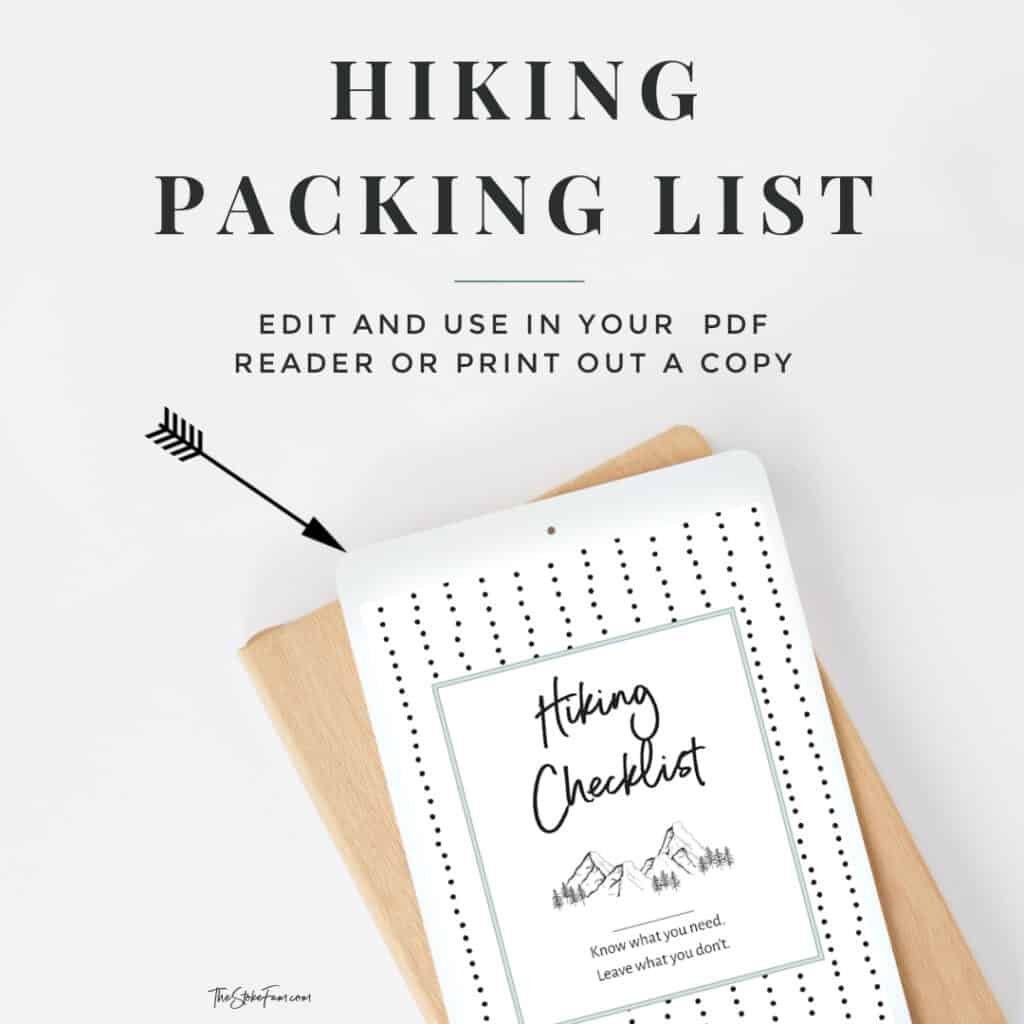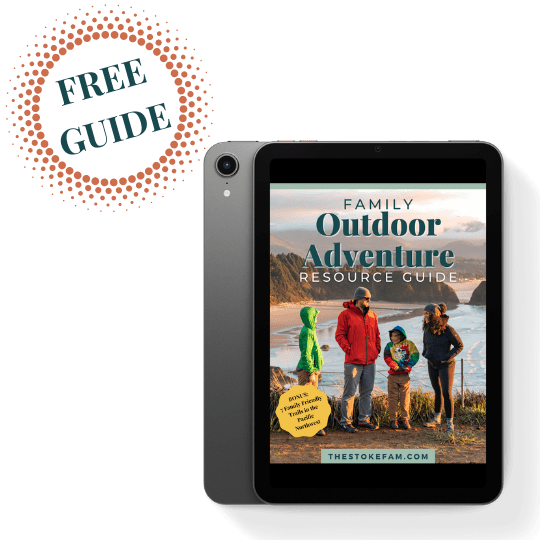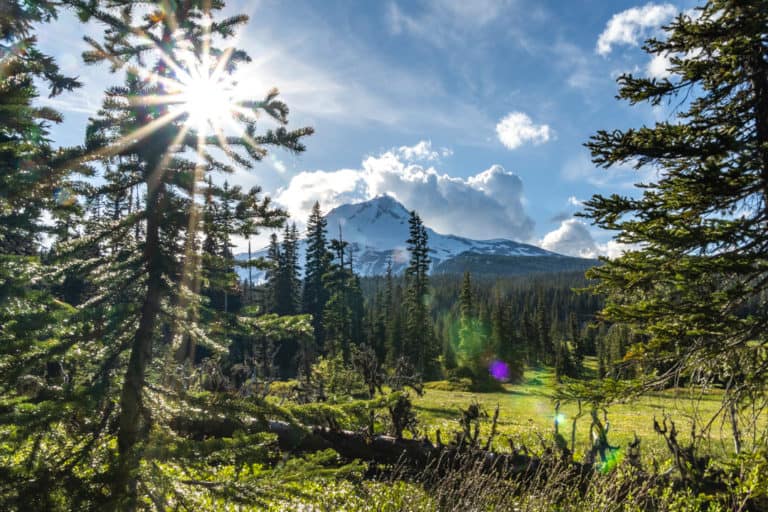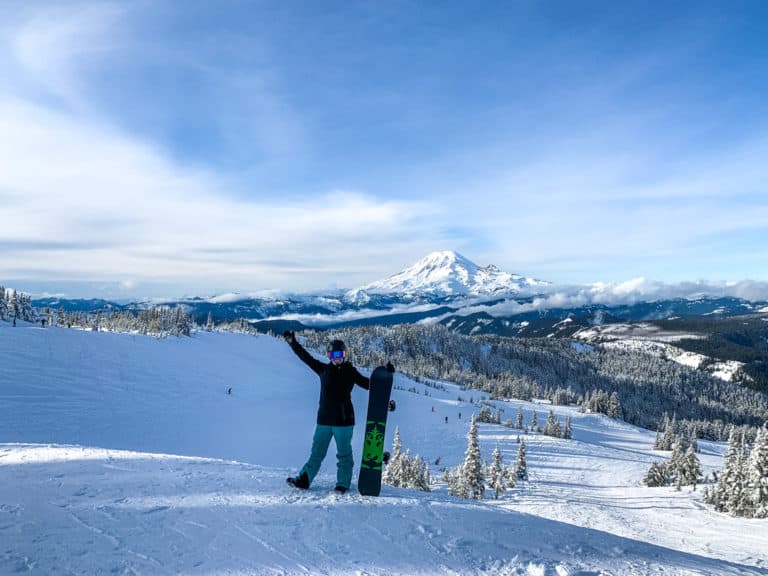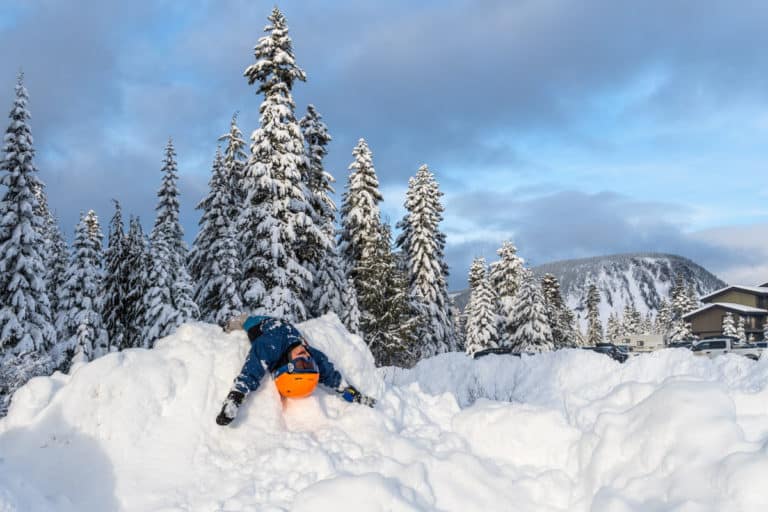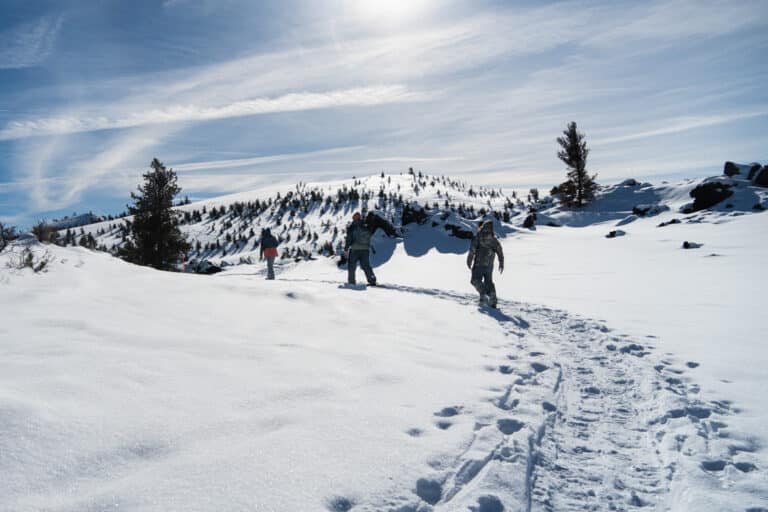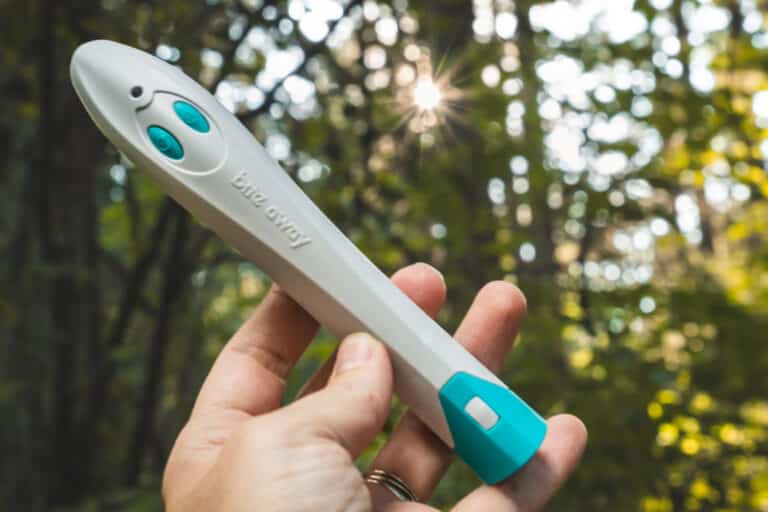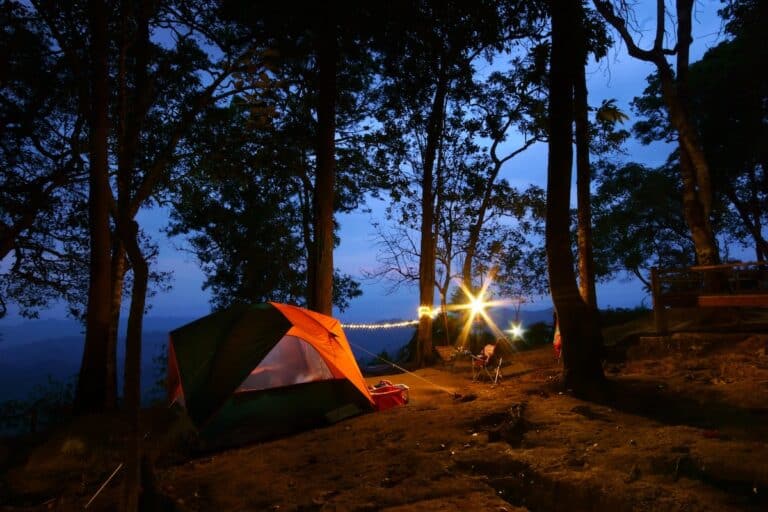Do you want to know how to dress like a pro on your next hiking adventure? This guide will help you figure out what to wear when hiking and how to plan your hiking outfit wisely. Having the right gear can help make hiking more enjoyable and help prepare you for whatever nature throws your way.
When you’re trying to figure out what to bring, it can feel a bit overwhelming. You want to make sure you’re prepared for any situation, but the last thing you want is a backpack full of things you don’t need weighing you down.
So what do you actually need on a hike? And why does the clothing you bring matter so much?
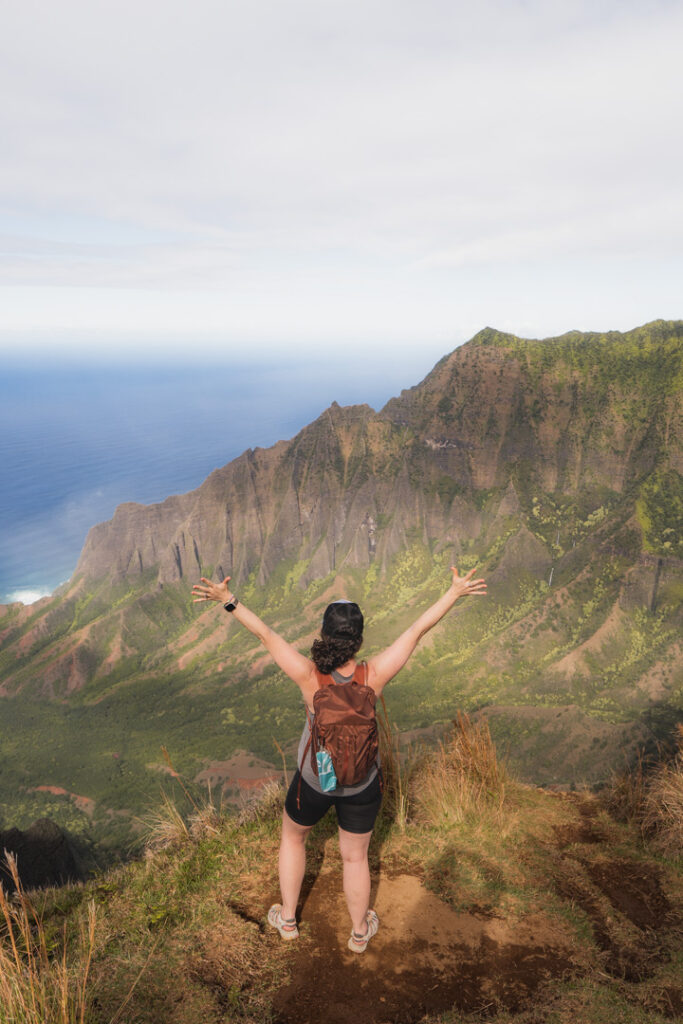
The Importance of Hiking Attire
While choosing the right clothes to wear on your next day hike, you need to think about more than just your comfort levels.
You must consider everything from the never-predictable weather, pokey bushes, pesky bugs, and other trail conditions such as mud tracks and slippery slopes. This means you can quickly find yourself with a complete change of clothes in your backpack.
If you are going to be hiking regularly, you should invest in clothing that is appropriate for hiking. This will ensure you are prepared no matter the conditions of the trails and the weather.
Hiking Clothing & Gear Checklist
Whether you’re new to hiking or a seasoned adventurer, making sure you have the essentials when you head out the door is key. You don’t want to end up somewhere to realize one of your kids doesn’t even have shoes (ask me how I know 😅).
Before we get into what to wear hiking, go ahead and grab yourself a copy of our hiking checklist to save you stress and get you on the trail faster.
What to Wear Hiking: The Basics
When you are new to hiking, it can be easy to overpack or buy things you don’t need. Many hikers buy more than they need and end up making hiking harder on themselves by overpacking or buying incorrect equipment for hiking. It’s important to know what to bring on a hike and what you can leave at home.
Underwear
Whether it’s boxers or bikini-cut underwear, it is fine to stick with your personal preferences. You want something that will be a supportive fit with breathable material. Make sure you have underwear that is non-chafing and that fits you well. My personal favorites are merino wool underwear because they wick moisture and resist stink.
For ladies, choose a sports bra that fits your size and the intensity of the hiking you will be doing. Another option, and one of my favorites, is a wool bralette.
Pants
Trails have twists and turns. When hiking, you want pants that can keep you warm in the winter and help protect you from mosquitos and sunburn in the summer. Loose branches from trees and boulders can tear yoga pants and other thin clothing. Pay attention to the fit and durability of your pants. Here are some of our favorites that are both comfortable and durable:
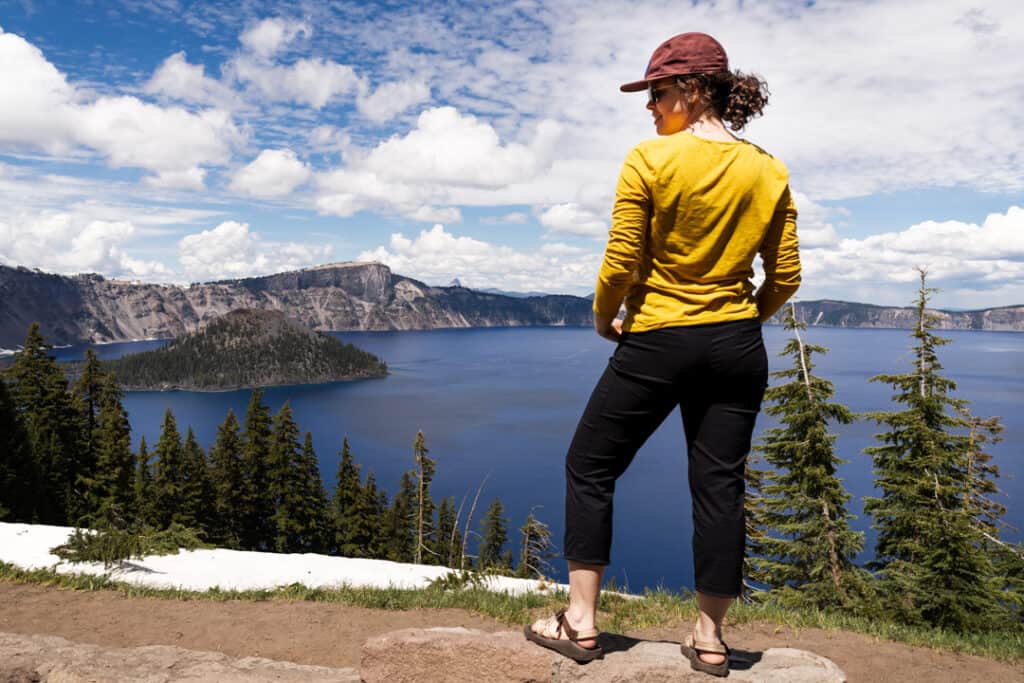
Shirts
Hiking all day can make you start to work up a sweat. When looking for hiking shirts, you want to ensure you have something that moves sweat off your skin and dries fast. Breathable t-shirts can help keep you cool during warm months, and lightweight long sleeves can help you stay warm during the cooler months.
Outerwear
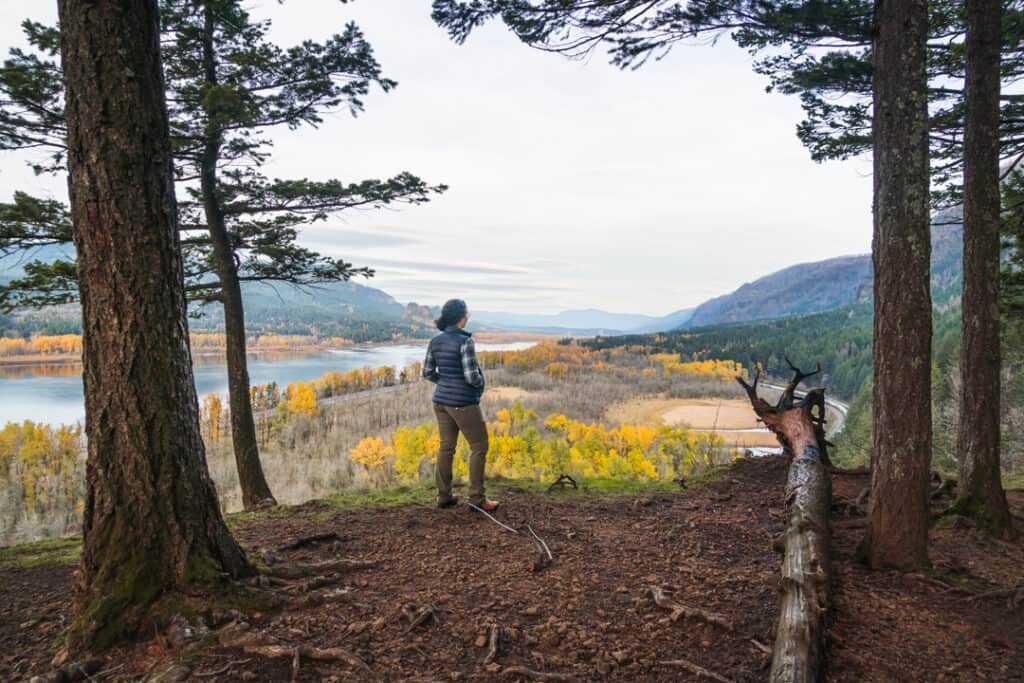
Jackets can serve several purposes while hiking. It can be used to keep you warm on cold days and to help with fluctuations in temperature during all-day hikes. Puffy jackets or vests are the better pick for midlayers for colder conditions. They are also lightweight and compress for easy packing. However, polyester fleece can also work as a layered jacket option.
- Midlayer Puffy Jacket Mountain Hardwear: Ghost Whisperer
- Midlayer Puffy Jacket Mountain Hardwear: Kor AirShell Warm Jacket
- Mountain Hardwear Deloro Down Vest
Warm Mid-Layers
Mid-layers are what sit between your base layer and the outer layer. The purpose of this type of layer is to help with insulation. If it’s cold and dry out, it can be a down jacket, but if temperatures are mild, you might want a lightweight fleece jacket instead.
Look for breathable and heavier-weight materials such as fleece or other synthetic mid to heavyweight fabrics.
Rain Gear
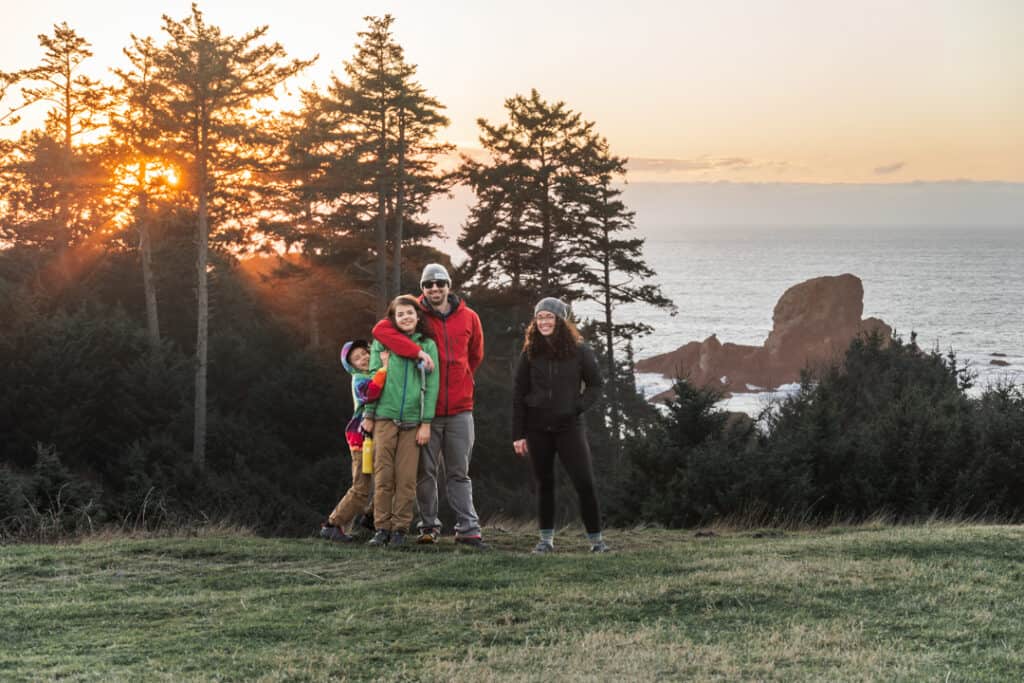
You may not only need layers for warmth. Having a waterproof layer is important, regardless of the weather forecast. You can get caught in an unexpected rainstorm mid-hike. Having a good rain jacket and shoes that have traction on slippery trails can help you stay dry and keep you warm.
Look for rain jackets that are designed for hiking, are lightweight, and packable so you can easily pack them on the hike. Rain pants are also an option to keep your pants and your legs dry. In the winter, during rainy hikes, remember that staying dry = staying warm.
Sunglasses
You need to bring some type of eye protection while you’re hiking during the day. Whether it’s hot or cold, your eyes can easily be damaged by the sun’s UV rays. Sunglasses will also help to protect you from foreign objects getting in your eyes.
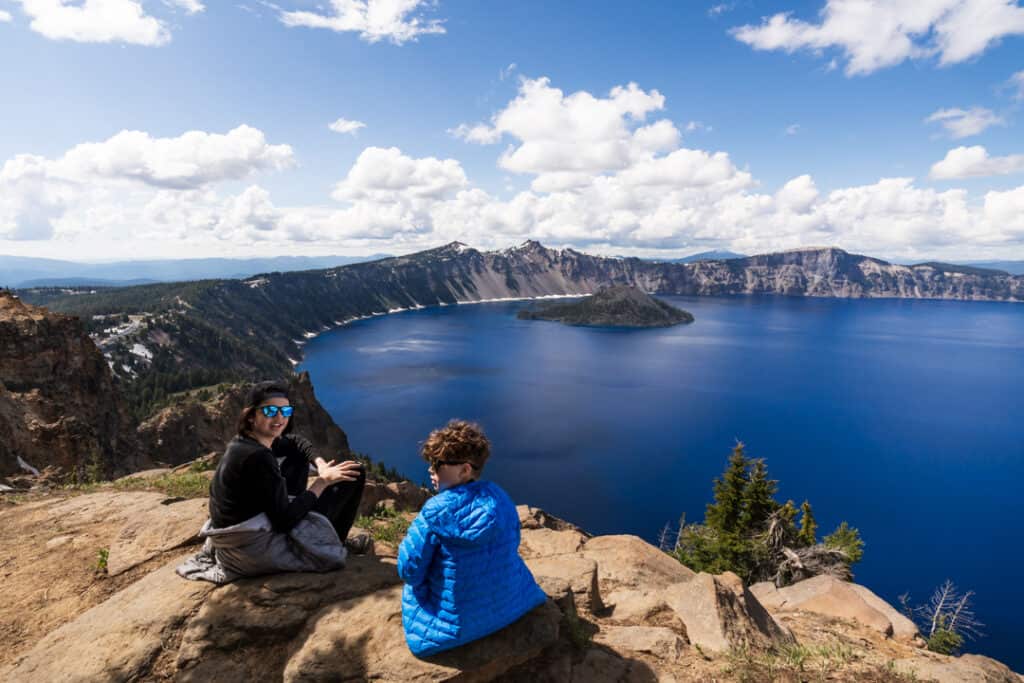
Sun Protection
Even during the winter, you can still get sunburnt. As you hike up to high elevations, the atmosphere thins so you can get sunburnt easily. In addition to packing your sunscreen, bring a brimmed hat or some sunglasses to help protect your body from sunburn. Wearing UPF-rated light long-sleeve shirts can be a huge help during exposed trail hikes.
Base Layers
Base layers are the articles of clothing that will be next to your skin. The primary goal of this layer is to help pull moisture from your body and help you regulate temperature. These layers will keep you warm during the winter. For this piece of clothing, you need something that can keep you warm and that will dry out quickly if wet. You’ll want to look for synthetic fabrics or wool for this layer.
Socks
You will want to go thicker or thinner for your socks based on the weather conditions. Socks should be higher than your footwear; ensure you bring extras just in case they get wet! This can help avoid blisters and squishy feet. As with other layers, you’ll want to look for wool or synthetic materials that wick moisture away from your skin.
- Darn Tough (they have a lifetime warranty and are a terrific value)
Hiking Boots and Shoes
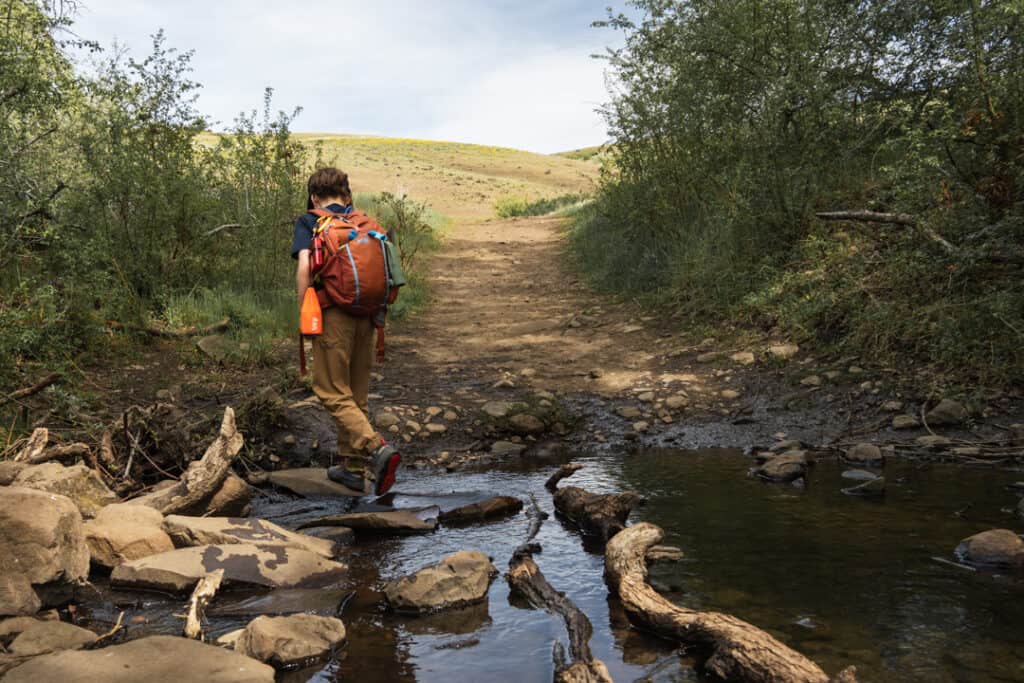
If you’re hiking, you will want to have sturdy shoes. Your hiking footwear doesn’t have to be leather boots, but they should provide support, protect your feet from rocks or roots, and provide traction on any wet or dry surface.
- Altra Lone Peaks (We all love these for summer and fall hikes. The ALL-WTHR option is excellent for winter and spring.)
- Oboz Bridger
- Oboz Bridger 7” Insulated Waterproof Boots (these are my favorite hiking boots for winter hikes)
- Chaco or KEEN Sandals: For summer or trails when you’re likely to be in and out of the water, sometimes a sturdy hiking sandal is the best choice.
VIP gear stoke
Personal Outdoor Gear Shopper
Overwhelmed by all the choices out there? No idea what to look for in gear? Wish there was an easy button?
I’ve spent years trying different brands and adventure gear so you don’t have to. As your outdoor personal gear shopper, I’ll help you find exactly what you need, quickly and efficiently.
What to Wear Hiking for Each Season
One of the first things you’ll want to do when planning out your hiking trip is to look at the weather on the day of your hike. Keep an eye on the weather leading up to the day of your hike, including anticipated fluctuations in temperature throughout the day. I suggest always packing an extra layer beyond what you think you’ll need, such as a jacket, just in case. It’s important to have the right hiking clothes for different seasons in order to have a great time on your adventures.
- Spring/Fall: A long sleeve shirt, pullover, or windbreaker
- Summer: Light jacket
- Winter: Fleece or puffer jacket or waterproof shell
When hiking in the PNW or at higher elevation, the weather can be unpredictable in any season. Use your best judgment if you’re on a short hike at a low-elevation park or local nature preserve. Otherwise, I recommend always keeping a warm layer, such as a down jacket, and a waterproof rain jacket in your pack.
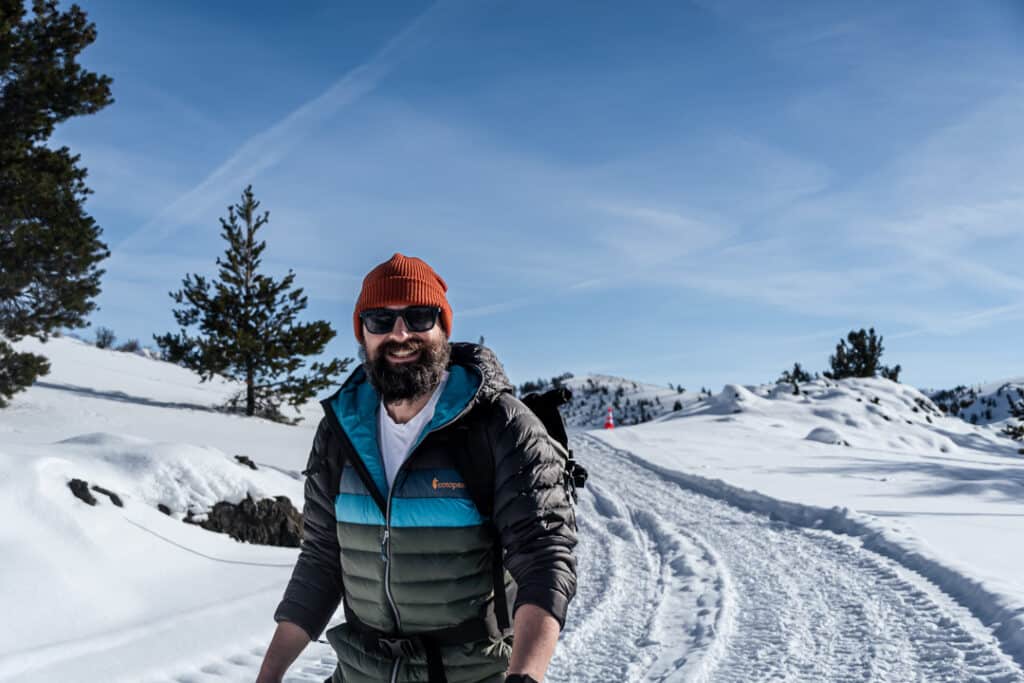
What to Wear Hiking in the Winter
Hiking during winter doesn’t have to be a cold and miserable experience. In fact there are plenty of options for what to wear hiking in winter. When the temperatures drop, you want to layer your clothes like an onion. This will help your body keep the heat and provide you with insulation and warmth on your hikes.
During the winter months, your goal with clothing is to help control your body temperature without overheating under all your layers. You want to stick with synthetic fibers such as polyester or a natural fabric such as wool. These fabrics are designed to keep you warm, while still being breathable.
What to Wear Hiking in the Spring
The spring months can be tricky because the weather can fluctuate between freezing and hot day to day. You should also prepare for windy and rainy weather, as spring weather can be unpredictable. You will still want to pack layers, but not as much as during the winter months.
A pair of gloves, neck gaiter, or a hat can help you layer up without adding so many layers that you overheat during your spring hikes.
What to Wear Hiking in the Summer
Unless you get a random cold front in the middle of summer, you will want to stick to light and loose-fitting clothing for your summer hikes. You should stick to light-colored shades or whites to help reflect heat. Dark clothing absorbs heat and will keep you from staying cool in the summer sun.
Summer Hiking Shirts
Here are a few of our favorite shirts for hiking in the summer:
- This UPF 50+ rated long-sleeve from Mountain Hardwear
- Another UPF 50+ rated long-sleeve from Patagonia. My husband owns this style and wears it All. The. Time. It comes in womens, kids, and even toddler sizes (with the cutest prints) too!
- Title Nine Ravine Muscle Tank and Notton Racer Back Tank – These two *almost* feel like cotton, but are made of special wicking poly blends that also resists odors.
- This super lightweight cropped tank from lululemon is one of my new favorites. (I wore it hiking in Kauai!) While technically a running shirt, it’s lightweight, flowy, and comfortable in the heat.
- For a short-sleeve option to prevent friction from backpack straps, this Mountain Hardwear option is great! It has a UPF 30 rating, is breathable, and comes in a variety of colors to fit your style.
Stick to synthetic fabrics, such as nylon and polyester, or lightweight wool (yes, really!) to help with fast drying and sweat absorption. While it can be tempting to throw on a pair of shorts and a sleeveless top, you’ll want to evaluate your destination carefully first. If you’re hiking a trail with lots of brush or an exposed ridge, pants and lightweight long sleeves can protect your skin from scratches, bug bites, poison ivy, and sunburn. In addition, backpack straps can also rub uncomfortably on your skin when wearing a tank top, so we recommend checking where your straps hit before you hit the trail.
Summer Hiking Pants and Shorts
Some of my favorite hiking pants and shorts for our family are:
- Women:
- If you’re someone who loves to live in leggings (👋 it’s me – I’m someone), these hiking shorts from lululemon should be on your radar! The high rise and longer length is great, but my favorite feature is the abrasion resistant fabric that’s designed to wick sweat. 🙌
- These shorts from Vuori are super lightweight, comfortable and cute and I like the slightly longer inseam to prevent thigh rub.
- These Prana hiking pants are always in my rotation. They are durable, have a bit of stretch, and look cute!
- Last, from Title Nine, I love the Switchback Hiking Shorts, Recycled Clamber 2.0 Capris, and Big B Pants.
- Men:
- My hubs wears these Prana pants everywhere. Literally. He takes them hiking, camping, to town, and even around the house. They’re breathable, move with him, and must be comforable becuase he keeps buying more, lol!
- If it’s too hot for pants, he reaches for the same style from Prana in a pair of shorts. They come in an 8″ inseam, 10″ inseam, or a 12″ inseam and have the same comfy fit. My teen wears these too!
- Kids:
- For younger kids, these shorts from Columbia or these from Patagonia are comfortable, breathable, and dry quickly – perfect for summer!
What to Wear Hiking in the Fall
Hiking during fall is one of the best times to go, but also the most unpredictable, even in early fall. Temperatures and weather conditions can change drastically day-to-day (or even hour to hour) and figuring out what to wear hiking in fall can feel a little challenging.
You want to aim for a layering system composed of quick-drying fabrics and breathable leggings or pants. For cooler hikes, a zippered jacket or breathable mid-layer can help provide warmth and ventilation. In the northwest, a rain jacket is a must for all fall hikes – you never know what you’re gonna get! 😉
The Best Type of Fabrics for Hiking
Merino Wool
When you think about wool clothing, you may imagine itchy wool socks and sweaters. However, today’s wool isn’t like the old-school wool you might have in mind. Merino wool has delicate fine fibers that make it breathable and soft to the touch. It won’t retain odors and dries quickly.
Polyester/Nylon
If you’re looking for a more affordable option, you can always wear polyester or nylon clothing. These work well to combat sweat and fast dryness, making them ideal for hiking conditions. The only downside to these types of synthetic materials is that they can have a funky smell. Some fabrics now combat stink with features like “StinkStopper,” such as the Henerela and Ravine lines from Title Nine. You can also prevent this by washing your clothing right away and consider adding an odor eliminator to your laundry.
Fleece
Fleece jackets are made of polyester, and their warmth can be essential for early morning hikes when it’s still chilly or for hiking during winter.
Cotton
Cotton tends to be the least ideal option for hiking. It’s just not as good as other materials for hiking because it doesn’t dry quickly and can actually soak up sweat. This will leave you feeling cold and wet on your hike. This is the last thing you want on a long hike during the cold winter months. It can actually increase your risk for hypothermia. There is a reason why seasoned hikers are never in cotton!
Important Factors When Choosing Hiking Clothing
While looking stylish on the trail can be a bonus in photos, there are some considerations you need to think about before purchasing your hiking clothes.
- Safety: Depending on the weather conditions and the trails you’ll be hiking on, you may need to think about different cuts or materials for your hike. As an example, if you’re hiking in an area with a lot of mosquitoes, you’ll want to wear long pants and sleeves, even during the summer months. If you’ll be hiking in the rain, a windproof rain jacket will be essential.
- Comfort: How do your clothes feel? When I started hiking, I focused on how it looked and made sure it was fitted. This meant I didn’t have as much range of motion on my hikes, and it was a lesson learned from experience. Choose looser clothing that is more flexible and comfortable. Thankfully, hiking gear has come a long way, and brands are now making clothing that can be both cute AND allow you to move easily.
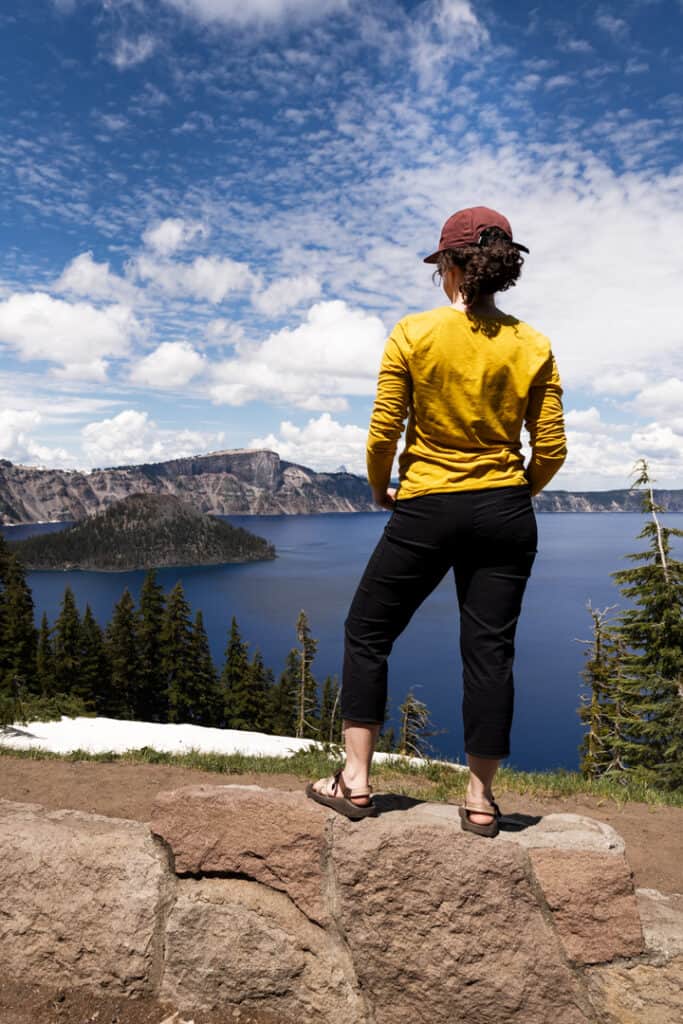
Dress in Layers
While on the trail, you want to have options. Conditions can change in a matter of minutes while you hike and your body as you go through periods of both exertion and rest. Wearing light layers that sit against your body, such as shorts, pants, short-sleeve tops, and base layers in colder conditions.
It’s best to wear or bring layers. While it might be hot in the car or when you start your hike, it can change midway through or when it’s too late to swap your outfit.
If you’re hiking during colder months, an insulating layer such as a puffer jacket can be a better option. Keep it in your backpack while you’re hiking, and then pull it out while you stop for a snack or to take in the scenery of your hike. Be sure to bring a hat, gloves, or other layers you can easily add if you need them but don’t take up much space.
Avoid Cotton
When you’re layering for outdoor hikes, you want to stick with materials such as wool or synthetic instead of cotton. Cotton doesn’t dry quickly, and it can stick to your skin. Wool and other synthetic blends keep moisture away from your skin which will help you stay dry and keep you warm.
Choose the Right Socks
Having the right pair of socks is almost as important as having a backup pair. No matter what kind of outdoor adventure you have in mind, you should always bring a second pair. You’ll also want to choose a synthetic blend or wool to wick moisture from your skin. Wet feet, whether from water or sweat, during hikes can lead to blisters and make your hike uncomfortable.
Look at What You Already Have
You may be surprised to find how many of these items you already have on hand. Use what you have first, then start to invest in quality items over time. As you have the money for them and as you feel ready for them, start adding to your collection. If you’re not sure what you like, it’s okay to ask to borrow an item to try out, rent, or shop used to save money.
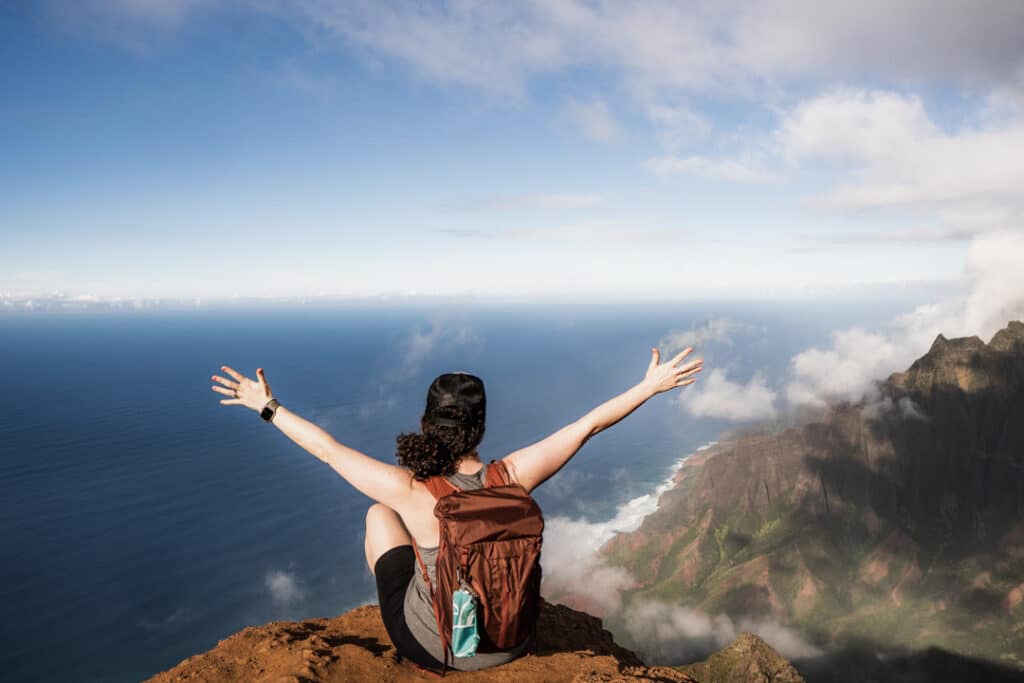
FAQ
How should I dress for a hike?
The tips above are great for dressing and preparing for a hike. Make sure that, ultimately, you’re prepared for the weather and are dressed in a way that provides the best security and comfort for your body.
You want to be sure to take care of your feet, knees, and back – and think about that as you’re dressing for the day.
The weather also plays a huge role in what hikers choose to wear. Be prepared to pivot your clothing needs as the weather changes.
Should I wear bright colors when hiking?
Yes, bright colors are great when hiking. Not only is this a good way for others to see you, but it’s also a fun way to find the other members of your hiking party as well.
Hiking in wooded areas is a lot of fun, and wearing bright colors will keep you safer by alerting others to the fact that you’re a human and not an animal.
Should you wear black hiking?
You can, but it’s best to keep a few things in mind to make an informed decision.
Black is not an advisable color to wear while hiking in the heat of summer because it tends to absorb the hot rays of the sun. Black clothing can make you sweat more and make you feel hotter than it really is outside.
The color black tends to blend in with your surroundings while hiking in the woods. For these reasons, lighter colors are generally a better choice.
Should I wear jeans or leggings hiking?
We don’t recommend wearing jeans for hiking. Although they technically can be worn hiking, jeans make it more difficult to hike because they’re a stiffer fabric and will limit mobility. More importantly, if they get wet, jeans do not dry quickly and become very heavy. This can make hiking more difficult, cause chaffing, and even result in hypothermia.
Leggings can also be used but should be worn with caution for longer hikes as they may not provide enough protection. That said, there are a few brands out there making leggings designed for rugged terrain and use on the trail. Generally, they utilize more durable fabrics that won’t snag or pick as easily on rough surfaces.
What should you not wear while hiking?
In general, you want to avoid clothing made from cotton (it doesn’t dry quickly and can trap moisture rather than wicking it away from your skin). In addition, you should leave flimsy footwear at home.
Can you wear sneakers to hike?
Sneakers can be appropriate on paved nature trails or mellow, dry, flat trails. In general, we recommend a trail runner if you prefer a sneaker-style shoe as they will have better grip to accommodate for wet leaves, rocks, and other terrain you encounter. However, if you’re doing hikes with lots of elevation, lots of roots and rocks, or scree, you’ll definitely want the added support of a true hiking shoe or boot.
Do you have to wear hiking boots?
Not necessarily. Depending on the type of terrain you’ll encounter and the weather, you may be able to hike in trail runners, sneakers, or hiking sandals.
Final Thoughts on What to Wear Hiking
When you are heading out onto the trail for a hike, you want to ensure that you have some of these with you every time you go hiking. Whether you are looking for new hiking gear to add to your wardrobe or need help picking out the perfect jacket for your first hike, hopefully, this guide will help you find the perfect fit.


